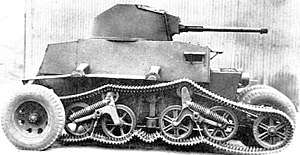Schofield tank
The Schofield tank, named after its designer, was a New Zealand tank design of the Second World War. Developed in 1940 when it seemed that the Pacific War might reach New Zealand and with little likelihood of weapons coming from Britain, it did not enter service. It was designed to run on either tracks or wheels.
| Light Tank, Wheel-and-Track (Schofield) | |
|---|---|
 The improved design | |
| Type | Light tank |
| Place of origin | New Zealand |
| Specifications | |
| Mass | 5.21 long tons (5,290 kg) |
| Length | 3.99 m |
| Width | 2.6 m |
| Height |
|
| Crew | 3 (commander, gunner, driver) |
| Armor | 6–10 mm |
Main armament | Ordnance QF 2 pounder |
Secondary armament | 7.92 mm Besa machine gun |
| Engine | Chevrolet petrol 6-cylinder 29.5 hp (22.0 kW) |
| Suspension | Horstmann suspension |
Operational range | 560 miles |
| Maximum speed |
|
Design and development
When a need for the production of indigenous armoured fighting vehicles arose in 1940, E. J. Schofield, a motor vehicle dealer for General Motors in Wellington, approached the government with his own design.
Schofield's tank was based on the chassis of a Chevrolet 6 hundredweight[1] truck using the suspension from a Universal Carrier. Wheels normally carried on the hull could be bolted on so that it could use these rather than the tracks. As initially designed it had a crew of three: machine gunner and driver at the front and a second machine gun in a turret at the rear.
The initial design performed badly in trials but the Government sought an improved version. Designed by another member of the original team, the improved model used a better transmission and the turret now contained a QF 2 pounder gun with a co-axial Besa machine gun. By the time it was complete, in 1942, New Zealand had received tanks from the UK and US.
The armour plating was provided by the New Zealand Railways. The four wheels shared drive and idler sprockets with the track, and the move from wheels to track, and vice versa, could be made from within the hull.
In 1943 the improved design prototype was shipped to Britain, where it was evaluated by the Department of Tank Design. Although not completely critical, the project was advised to be stopped. The tank was stored for a while and scrapped after the war.[2]
See also
Other Commonwealth Tanks of the Second World War
- Bob Semple tank – New Zealand improvised tank design
- Sentinel tank – Australian indigenous tank design
- Ram tank – Canadian indigenous tank design
- Grizzly tank – Canadian licence built M4A1 Sherman
References
Notes
- The term refers to its load carrying capability, not total weight.
- Fletcher, David (1989). The Great Tank Scandal: British Armour in the Second World War - Part 1. HMSO. p. 104. ISBN 978-0-11-290460-1.
Bibliography
- Cooke, Peter (2000). Defending New Zealand: Ramparts on the Sea 1840-1950s. Wellington: Defence of New Zealand Study Group. pp. 356–361. ISBN 0-473-06833-8.